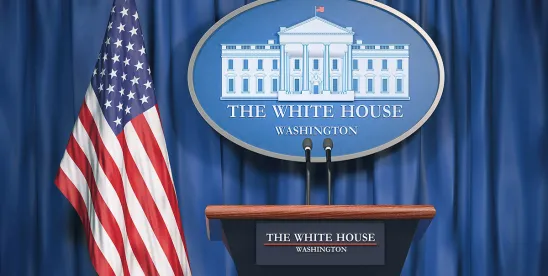The White House released its comprehensive Digital Asset Policy Report (Report), fulfilling a mandate from Executive Order 14178 signed by President Donald Trump on January 23.[1] The order established the President’s Working Group on Digital Asset Markets within the National Economic Council and gave it 180 days to develop regulatory and legislative recommendations that would advance pro-innovation digital asset policies. The Report continues the administration’s emphasis on developing digital assets and related technologies in the United States. Specifically, the Report addresses, among other things, banking supervision, market structure, international competitiveness and implementation of a national digital asset stockpile from seized cryptocurrencies. The Report provides specific recommendations to federal agencies while acknowledging that many changes will require legislation.
Banking Regulators Told to Restart Crypto Programs
According to the Report, federal banking regulators should restart crypto innovation programs that were previously suspended and establish clear approval processes for custody services, trading facilitation, and other digital asset operations.[2] Banking agencies should adopt technology-neutral risk management that treats digital asset activities fairly.
Capital requirements should “accurately reflect the risk of the asset or activity” rather than the blanket higher capital charges that have effectively discouraged bank participation in digital asset markets. The Report also calls for clearer guidance for institutions seeking bank charters or Federal Reserve master accounts for digital asset business lines, and directs regulators to stop discriminating against lawful digital asset businesses.
SEC and CFTC Should Immediately Act on Crypto
The Report urges the Securities and Exchange Commission (SEC) and the Commodity Futures Trading Commission (CFTC) to “immediately enable the trading of digital assets at the federal level” using existing authorities. Since this does not require new legislation, the agencies could act on this recommendation in a relatively short time frame.
More ambitious reforms would require legislation. The Report supports the Digital Asset Market Clarity Act of 2025 (CLARITY Act), which recently passed the House, calling it an “excellent foundation” for digital asset market structure. The CLARITY Act would grant the CFTC clear authority over spot markets in non-security digital assets while allowing SEC and CFTC registrants to engage in multiple business lines under streamlined licensing.
The Report addresses decentralized finance (DeFi) and recommends that regulators evaluate protocols based on four specific factors: 1) whether the software exercises “control” over assets; 2) whether it is technologically capable of being modified; 3) whether it operates with a centralized structure or management; and 4) whether it is logistically capable of complying with current regulatory obligations.
Stablecoins Receive Priority Treatment Under GENIUS Act
The Report calls for expeditious implementation of the GENIUS Act, which was signed into law in July and establishes a regulatory framework for payment stablecoins and their issuers.[3] The Report emphasizes three key aspects of the GENIUS Act that it considers “essential to enabling growth and stability in the digital asset market”: stablecoins must be backed by high-quality, liquid assets, issuers must obtain US licensing for domestic offerings, and the law allows US authorities to grant reciprocity to foreign jurisdictions with comparable regulatory regimes.
The Report maintains firm opposition to central bank digital currencies, recommending support for legislation like the Anti-CBDC Surveillance State Act, which passed the House in July 2025. This distinguishes the US approach from other major economies that are exploring government-issued digital currencies.
Bitcoin Reserve Implementation Details Revealed
The Report provides implementation details for the Strategic Bitcoin Reserve (SBR) and Digital Asset Stockpile (DAS), which were established by Executive Order 14233 in March 2025.[4] The Department of the Treasury has delivered initial considerations to the White House regarding the establishment and management of these holdings and will coordinate next steps to operationalize them.
The SBR and DAS serve distinct purposes with different operational parameters. The SBR treats bitcoin as reserve assets of strategic national importance and will maintain bitcoin holdings as a long-term store of value that will not be sold. The US Treasury and Commerce Departments are developing budget-neutral strategies to acquire additional bitcoin for the SBR without imposing taxpayer costs.
The DAS encompasses all other digital assets obtained through forfeiture, with Treasury retaining discretion to determine strategies for responsible stewardship of these assets. Unlike the SBR, the DAS cannot acquire additional assets beyond those obtained through forfeiture proceedings.
The Report explains that existing forfeiture programs will continue unchanged, with digital assets still used for victim compensation, law enforcement operations, and state sharing as required by statute.
[1]See Katten’s Quick Reads coverage of Executive Order 14178 here.
[2]See Katten’s client advisory on this topic here.
[3]See Katten’s client advisory on the GENIUS Act here.
[4]See Katten’s Quick Reads coverage of Executive Order 14233 here.
The [President’s Working Group on Digital Asset Markets] encourages the Federal government to operationalize President Trump’s promise to make America the “crypto capital of the world” and adopt a pro-innovation mindset toward digital assets and blockchain technologies.



 />i
/>i

